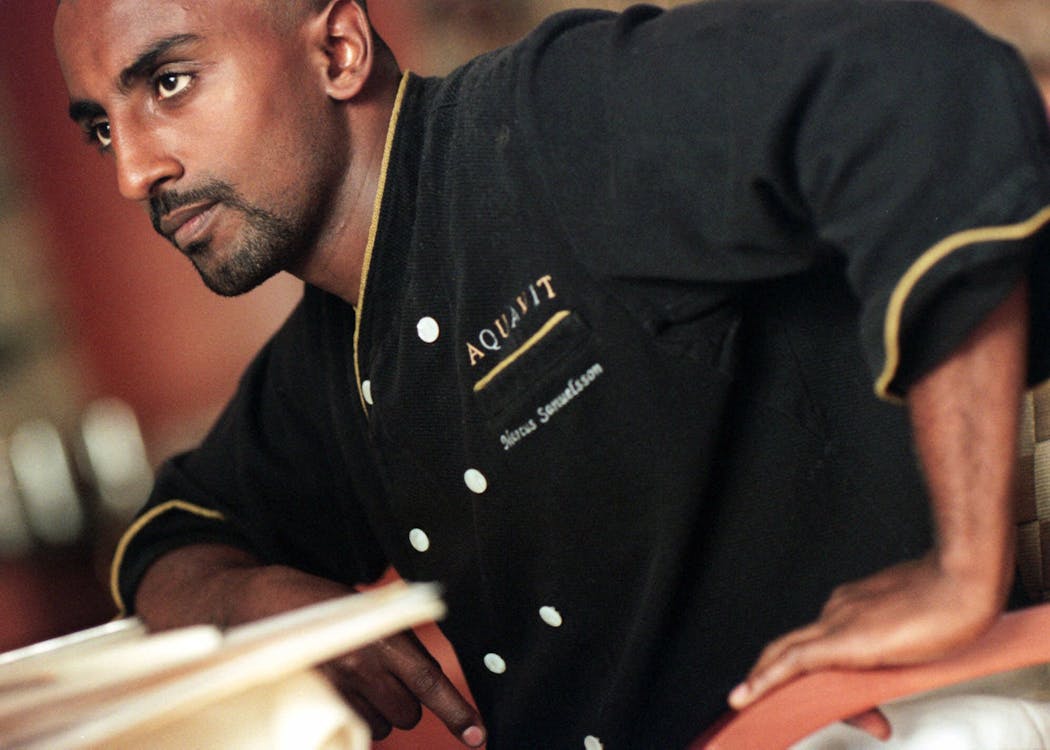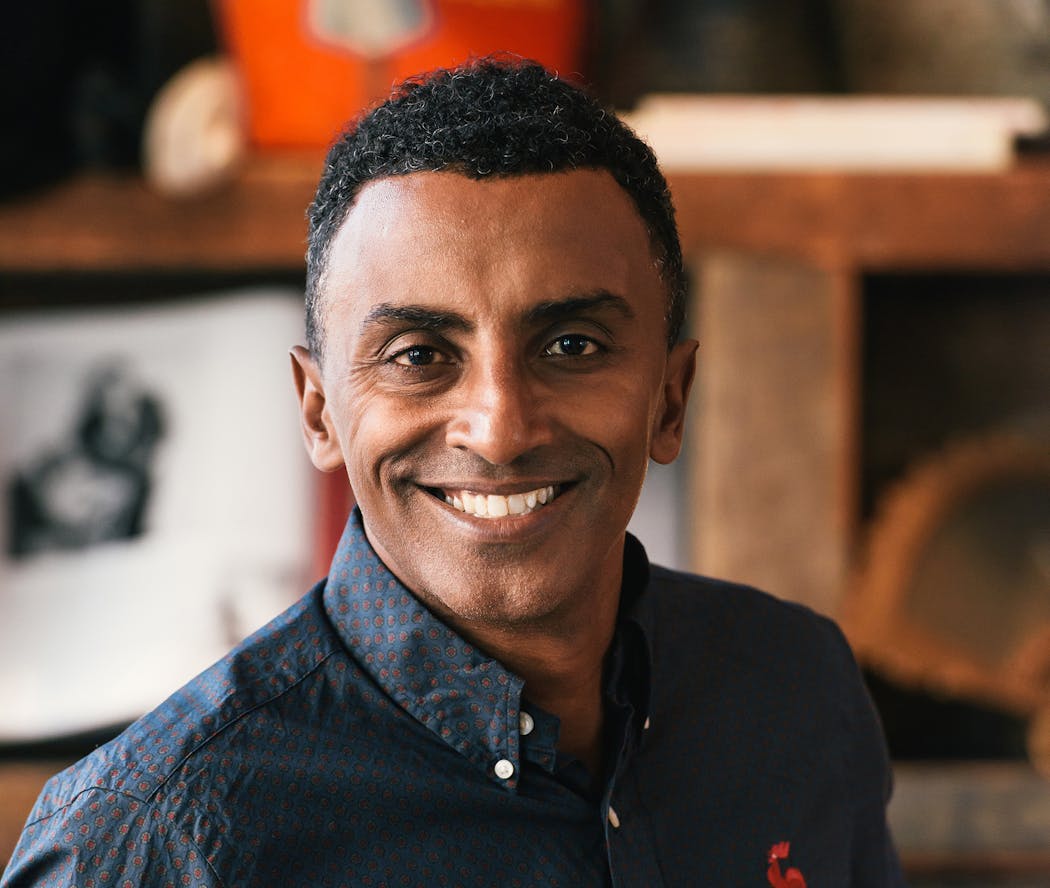Two decades after helming one of Minnesota's most talked about restaurants, Marcus Samuelsson is back.
The Ethiopia-born and Sweden-raised celebrity chef is appearing alongside Gavin Kaysen at Minneapolis' Spoon and Stable Dec. 1 and 2 as part of Kaysen's Synergy Series. At the sold-out dinners, Samuelsson will be sharing dishes from his just-opened restaurant Hav & Mar — his first new spot in New York City in 10 years. He's also headlining a dialogue event Dec. 2 at 1 p.m. (Both are sold out, but you can add your name to a waitlist.)
It's not Samuelsson's first homecoming by any means. Turns out, he just can't stay away from Minneapolis very long.
"First of all, I love Prince. So that's always a reason to come back," he said, not entirely joking.
But he also has a legion of local chef friends and food-world admirers cultivated from his time as co-owner of Aquavit. He brought the long-established New York City restaurant that showcased Swedish fine dining to the ground floor of the IDS Building in 1999, where it was a training ground for many of today's star chefs. It closed in 2003.
That Samuelsson is still considered one of our own is a testament to his, and Aquavit's, influence in helping to establish Minneapolis as a first-rate food city.
Minneapolis, in turn, is still a meaningful part of Samuelsson's story, too. "I will always be connected to it," he said.
We caught up with Samuelsson ahead of his Synergy Series appearance to talk about the evolution of the Minneapolis food scene, his beloved glögg, and whether he'll ever open another restaurant in the Twin Cities.
This interview was condensed and edited for length and clarity.
Q: It's amazing that Aquavit was here so long ago, and it's still part of the conversation about the Twin Cities' fine-dining trajectory. Was the restaurant ahead of its time?
A: I think that my feet are looking forward. And so are the people in Minneapolis. And I think in order to go forward, you have to come from an authentic place and space. When you think about fine dining, it's not just the place. It's also a training center for chefs, for staff, for leaders. So a lot of good things can come out of a great restaurant, even if the restaurant doesn't work at the time. I think that Aquavit was needed, in order for it to sort of aspire and set a new standard.
But maybe we also didn't know enough about Minneapolis to make it work. To make a restaurant work is very tricky, especially right after 9/11. But we did a lot of great things. I think that evolution was an important step in order to be where Minneapolis is today as an amazing food city.
Q: Have you spent much time in Minneapolis since Aquavit?
A: I come basically every 18 months and do some type of pop-up experience in Minneapolis. With [chefs] Andrew [Zimmern] and Gavin and J.P. [Samuelson] and Justin [Sutherland], I have a lot of great friends in Minneapolis that I met there as a young chef. And you know, I grew up in a similar climate like Minneapolis. The Swedish Institute is here. So there's a lot of connections.
Q: Are there any new restaurants here you're excited about?
A: I'm super excited about coming back when you have the Best New Restaurant last year for James Beard.
Q: Are you going to Owamni?
A: Yes, of course. That was one of the first things I wrote to Andrew [Zimmern], "We have to go." He was like, "I'll set it up."
And I'm just so proud of what Gavin does. I remember when he came to Red Rooster and talked to me about deciding to leave the Daniel [Boulud] world and come back home. And he always does things looking past, present, future. These dinners are amazing because there's a new Gavin there in that kitchen somewhere that aspires, and in 10 years from now, she might open her own place. But they have to learn from a specific place. So these dinners are not just important for the diners, but also very, very important for the next generation of somms, of mixologists, of chefs, of servers.
Q: What will you be doing for the dinner?
A: We have a five-course menu that actually represents Hav & Mar, our new restaurant in New York City, in Chelsea.
Q: Tell me a little more about Hav & Mar.
A: I hadn't done a new restaurant in New York for 10 years after Red Rooster, and I wanted to really take time to do a full-service restaurant. During the pandemic, we were serving meals with World Central Kitchen and closed Red Rooster as a traditional restaurant and became a community kitchen. Those four hours a day where I was passing out food helped me a) think about how much I love hospitality, and b) if I ever get a chance to do it again, I want to do it again in New York and I want to come up with a value proposition that was different, right? And really speak about my heritage, front and center. So, the Swedish side, the New York side, and the Ethiopian side all in one. And that's what the name Hav & Mar represents. Hav is ocean in Swedish. Mar is honey in Amharic in Ethiopia. And we're in Chelsea, so it's a love letter to New York City and Chelsea in particular.
Q: Is this something you would ever see yourself taking to other cities, oh, say, Minneapolis?
A: We are two weeks old at Hav & Mar. I look at my 10-month-old daughter Grace. She's learning to walk. And we're two weeks behind her. We are crawling right now, and then we've got to learn to walk. Ask me in a year when I can look up. But it's a fair question. Let's do this pop-up and see if we do well, then maybe, maybe one day.
Q: Switching gears, you mentioned being friends with Justin [Sutherland, TV host and chef at St. Paul's Handsome Hog]. Lately, it feels like we have even more chefs ascending into the limelight. What advice do you have for younger chefs who are just starting to gain national recognition and get out there in front of the camera?
A: I think it's learn your craft and love it. Because if you truly love your craft, the camera will not be a distraction. I worked 15 years straight, I didn't even know food media existed. But it didn't bother me because I loved my craft and I still love my craft. And I'm even more curious about food today than I was when I started. So I will love cooking whether there's a camera there or not. The great thing is that food is large, and now with TikTok and IG and all different platforms, the chances of articulating who you are are better than ever. I think focus on falling in love with your craft, and then you can figure out, how do I get this message out?
Q: With the holidays coming up, what's one essential thing you always need to make for your holiday table?
A: Well, glögg is always in our house. It's great because it smells amazing. And you can use really bad wine if you want to, because you do everything to it that you wouldn't do to good wine. You add sugar, spice. But it is that one thing, when you step into a house, especially in a cold climate, and you get that first cup of glögg, and your life is just better, you know?



